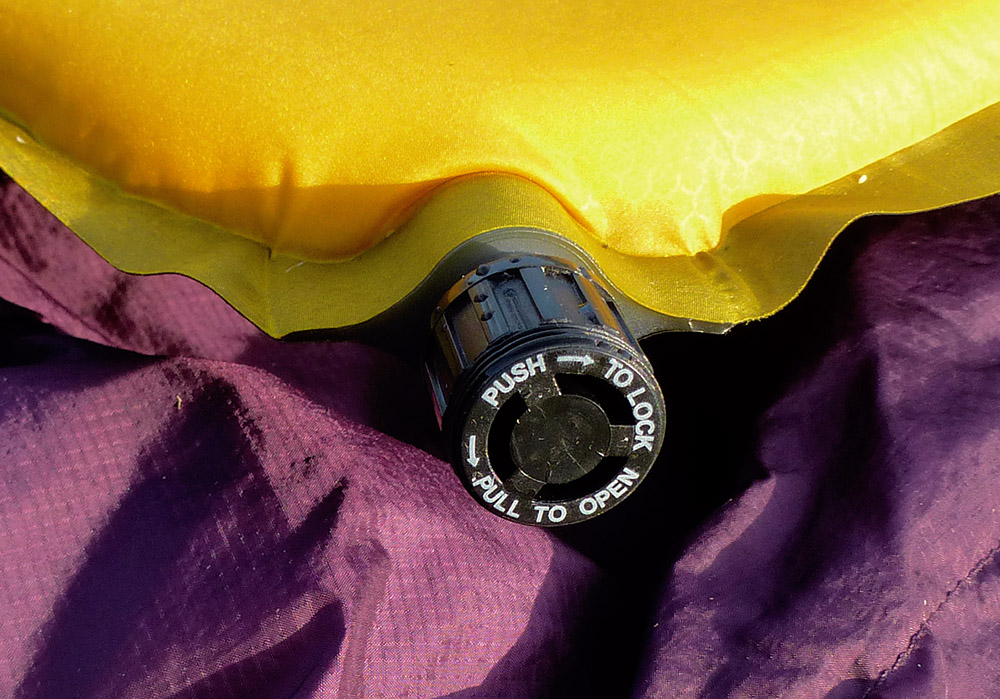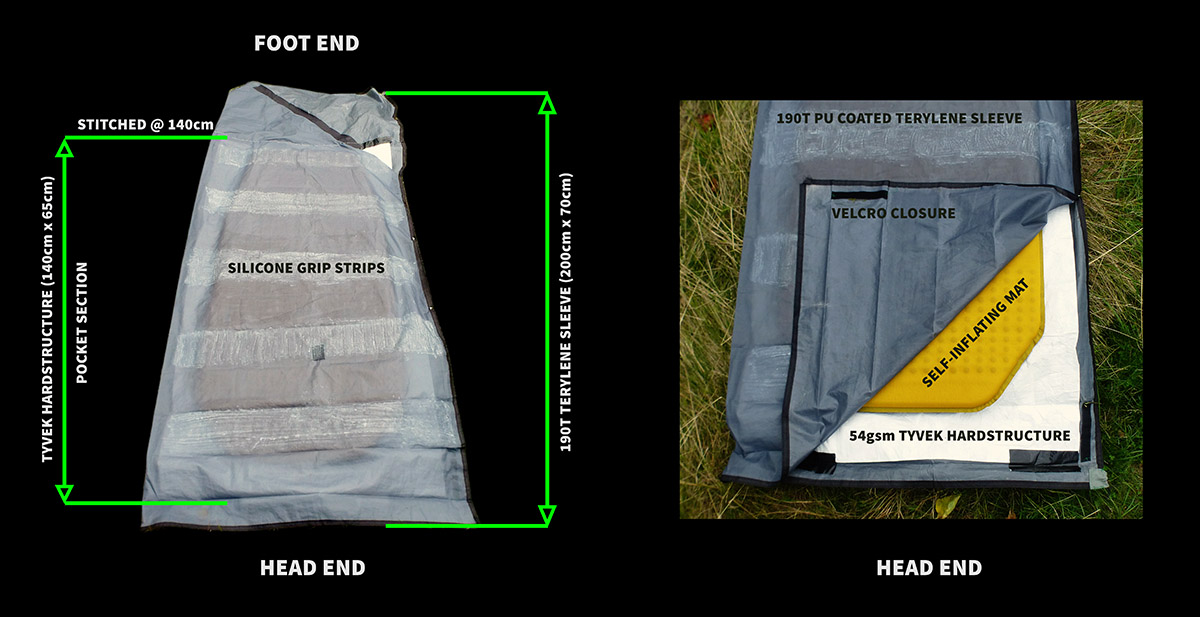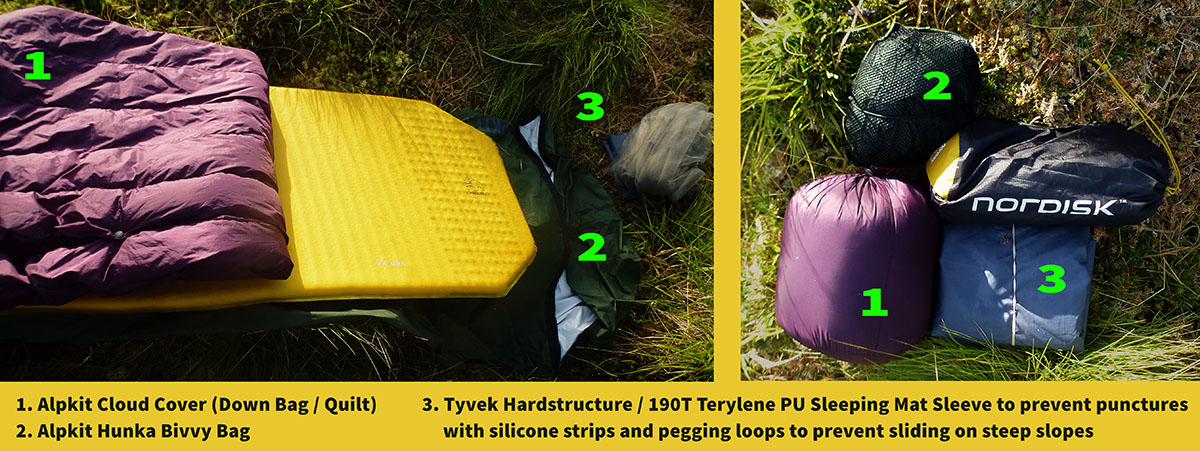Nordisk's Ven 2.5 Self-Inflating Sleeping Mat
Preface
As always, we're looking at the Nordisk Ven 2.5 from the point of view of long distance trekking over tough terrain.
Test subject: Chest 42", Waist 33", Height: 5ft 8"
Test item: Ven 2.5 (Current)
Kit Tests: Summer (official) & late Autumn / early Winter (unofficial)
Disclaimer: None required (item not provided by manufacturer)
Datasheet
| Materials (Top Side): 20D Honeycomb Rip-Stop Polyester (Mustard) | 100% |
| Materials (Under Side): 20D Rip-Stop Polyester (Black) | 100% |
| Filling: Foam (density = kg / cubic meter) | 12 |
| R-Value (standard measure of insulation - see below) | 0.41 (R-SI) / 2.3 (R-IP) |
| Mat Dimensions (Expanded): Length x Width x Depth | 122 x 51 x 2.5 cm |
| Packed Dimensions: Height x Diameter | 28 x 10 cm |
| Weight: Mat Only (Stated / Measured) | 280g / 296g |
| Weight: Stuff Sack + Strap (Measured) | 20g + 10g |
| Manufacturer RRP | £75.00 |
Scramble Review
Contents
- Introduction
- Design & Materials
- Packed & Stored
- Any Negatives?
- Conclusion & Rating
- Postscript: Tyvek-Based Inflatable Mat Protector & Groundsheet
Introduction: A Comfortable Compromise
The purpose of a sleeping mat is to provide sufficient comfort in the form of cushioning and insulation (from the cold ground) for a good nights sleep. Sleeping mats are on your back during the day, so the lighter the better, but go too light and you'll soon regret the sacrifice. Get the balance right and you'll be well rested without being overly burdened.
There are basically three types of sleeping mat:
- Closed-Cell Foam Mats
- Inflatable Air Mattresses
- Self-Inflating Mats
In simple terms, so-called "self-inflating" mats (which generally don't really self-inflate) are a cross between (1) and (2). This means you get some of the foam-based insulation from (1) and some of the comfort from (2). Self-inflating mats pack down much smaller than closed-cell foam mats, and require much less air to blow up than air mattresses.
There are plenty of guides (such as this one from AlpineTrek) that detail the various pros and cons of each type, so we won't go into that here. Instead, we'll just state that Scramble exclusively use short-length, self-inflating mats - a thicker, heavier duty one for sub-zero temperatures and a lighter one (reviewed here) for temperatures above freezing.
Coverage
The standard length for a full size sleeping mat is 183cm. The Ven 2.5 is 122cm long, so short really means a "two-thirds length mat", which is quite sufficient:
Assuming we can muster a pillow from our assortment of baselayers, softshells, insulated jackets and an air-tight dry bag, we can ignore the head and upper neck issue. The remaining boney areas of the body that really appreciate some cushioning are the hips, shoulders and back. So, to keep the weight to a minumum, a short-length (2/3) mat is really all that's required. For most people, 122cm will cover shoulder to at least lower thigh.
"What about my knees and feet!" Poor you! Well, if that's really a problem you can simply use your pack to provide some additional support and insulation for your lower legs and in winter this is precisely what I do. So, a short mat plus pack is all you really need tucked under your sleeping bag for a good nights sleep.
Insulation: Non-Standardised R-Values Explained
The standard measure for insulation is the R-Value. In simple terms, the higher the number the greater the insulation. However, and very significantly, this measure is NOT internationally standard. For example, the UK, Australia and NZ all use R(SI) which is metric and the US and Canada use R(I-P) which stands for Inch-Pound which is imperial. The R(I-P) Value is 5.68 times larger. So simply put, if you see an R-Value above 1.0 it's very likely using the R(I-P) measure and not R(SI). The table below is useful, so at Scramble we convert all R(SI) values into R(I-P) and in the datasheet (above) quote both.
The Nordisk Ven 2.5 has a quoted R-Value of 2.3 which means they're using the R(I-P) measure.
Manufacturers like Multimat use the Tog rating to get around this confusion. To convert Tog to R(SI) you simply divide by 10. So a Tog value of 5 converts to 0.5 R(SI).
To make this as clear as possible, we'll use a real world example and compare the Ven 2.5 to Multimat's Expedition range Summit 38S mat, which we recommend and use for sub zero treks. The Ven 2.5 has a quoted R(I-P) of 2.3. The Summit 38S has a Tog Value of 7.95. Let's see how they compare:
- Tog > R(SI) Conversion: 7.95 / 10 = 0.795
- R(SI) > R(I-P) Conversion: 0.795 x 5.68 = 4.52
So the Summit 38S (4.52 R-IP) is about twice as warm as the Ven 2.5 (2.30 R-IP) which makes sense and corresponds to our experience. Now we can use this useful table (from GearX.com) to see their operating ranges:
As you can see the Nordisk Ven 2.5 (R=2.3) is easily adequate for temperatures above freezing and the Multimat Summit 38S (R=4.5) is good down to around -30°C.
Hopefully that clears things up. If you want more background on the kinds of confusion this causes, Multimat have an excellent article entitled: "Don't be fooled by over-inflated R-values".
That's enough on international units, let's see what the Ven 2.5 has to offer.
Design & Materials
The Ven 2.5's outer material is 20D rip-stop polyester which hosts an ultra-lightweight zoned "memory foam". The foam is made using vertical and horizontal drilling (2-Axis Coring) which keeps the weight to a minimum.
The Ven 2.5 is 122cm long and 51cm wide and only gently tapers below the hip.
 View from the top - note the valve positioned at the lower end
View from the top - note the valve positioned at the lower end
Fully inflated, the Ven 2.5, as its name suggests, is 2.5cm deep and looks like it won't provide sufficient cushioning, but it's extremely comfortable and during the last 12 day Summer Kit Test (2018) I slept 11 consecutive nights in a range of locations from high grass marshland to rocky mountain outcrops using a tarp and bivvy setup and slept extremely well. In fact, overslept on two occasions.
The valve on the Ven 2.5 is excellent. Simple to use and highly effective, it provides an absolutely air-tight seal. The mat takes approximately four large breaths to fully inflate.
 The Ven 2.5 has an excellent valve and is quick and easy to inflate
The Ven 2.5 has an excellent valve and is quick and easy to inflate
Packed & Stored
To pack you simply fold it down the middle and then roll toward the valve at the end. Nordisk provide a good quality strap and stuff sack. If one wanted to save a few extra grams the strap could be replaced with a simple velcro strip and a lighter stuff sack would be easy to find. But ultimately we're talking about shaving off 15g max.
When packed the Ven 2.5 is approx 28cm long and just 10cm in diameter. A pretty tidy package.
 The Ven 2.5 is easy to pack and doesn't take up too much space
The Ven 2.5 is easy to pack and doesn't take up too much space
A Brief Note on Long Term Storage
Just as sleeping bags should not be stored compressed in their stuff sacks, the same goes for self-inflating mats. If stored packed, the foam will get overly compressed and won't be able to full expand when inflated.
When you inflate the mat, moisture from your breath gathers inside the foam. This is not a big deal during a trek, but can be when stored for long periods.
When storing the Ven 2.5, inflate it fully but keep the valve open; some air will escape but the foam won't be compressed. If stored vertically, make sure the valve is at the top. With the valve open any residual moisture will evaporate and won't negatively impact the foam.
Any Negatives?
Aluminum magnesium boride (BAM) is possibly the most slippery material in the world. Perhaps Nordisk were vying for that crown when they created the Ven 2.5. When the Ven 2.5 comes into contact with standard outdoor synthetic materials like those used in bivvy bags, sleeping bags or tent floors, it's fine ... unless there's a slope, at which point say goodbye because you're gliding down it. Unless attended to, this could be a major annoyance. Fortunately, it's easily remedied with a little silicone. However, this is not ideal and we've deducted 2 points from its function score.
We recommend painting 3 or 4 broad lateral strips of silicone (100% clear silicone mixed with white spirit in a 50:50 mix) across the top and bottom side of the Ven 2.5. This will: a) prevent it slipping on a tent floor or ground mat; and b) prevent a bivvy bag or sleeping bag from slipping off its surface.
Personally, I always use a simple protective ground / sleeping mat sleeve - pictured below (3) - and so the Ven 2.5's slipperiness isn't an issue, but for some it could be and so has to be noted.
Aside from its slippery slopeyness, which can be easily fixed, the Ven 2.5 is pretty much flawless and overall, an excellent bit of kit.
Conclusion & Rating
Nordisk's Ven 2.5 is a high quality, lightweight, ideally proportioned, self-inflating sleeping mat that provides a high degree of comfort for its low weight and sufficient insulation to handle nighttime temperatures just below freezing (tested down to -2°C).
The Ven 2.5 comes with a well finished stuff sack, a good quality strap and includes a puncture repair kit (as most do).
Its one weakness is its slipperiness when in contact with synthetic materials like those used in traditional groundsheets, tent floors, bivvies and sleeping bags. However, this weakness can be easily remedied whether directly or indirectly and though noteworthy is not unique to the Ven 2.5.
Without this minor slippery negative, the Ven 2.5 would be almost perfect, instead it's just extremely good and is Scramble's top pick in our 3 Season Sleeping Mat category.
Product Images
Rating (out of 10)
* The value score is derived from two factors:
1) Competitive Market Price (CMP). This represents our judgement of a competitive online price point if we were to stock the item. e.g. if we feel we would need to sell an item at 40% off (i.e. 60% of its full RRP) to be competitive, then our CMP score will be 6/10.
2) Customer Value Price (CVP). We then make an honest appraisal of the maximum price we would be willing to pay for the item (and we're mean). So if we'd pay 80% of its RRP our CVP score would be 8/10.
We then average the two scores to get our final value score, which in our example would be 7/10.
Postscript: Tyvek Hardstructure - Inflatable Mat Protector
Many of the Scramble team use some kind of variation of the item pictured below; a lightweight, high thread-count, low denier, waterproof material with a Tyvek Hardstructure insert, which acts as both a groundsheet and a protective sleeve / pocket for self-inflating mats.
Since using these (simple to make) sleeves, none of the self-inflating mats I use on a regular basis, nor any I've tested, have had a puncture (this was not the case prior).
Below is the one I use with a Bivvy Bag + Tarp setup:
 Scramble Editor's Mat Protector Sleeve / Ground Mat for tarp + bivvy bag use
Scramble Editor's Mat Protector Sleeve / Ground Mat for tarp + bivvy bag use
Here's why I use it:
- Acts as a traditional waterproof groundsheet in wet conditions
- Protects inflatable mats from punctures and allows the user to pitch on far from ideal ground
- Prevents slippery mats like the Ven 2.5 from sliding on steep slopes and can be pegged to the ground if the slope is very steep
- Broad silicone strips prevents bivvy bags / sleeping bags from sliding off slippery inflatable mats on non-ideal pitches
- Tyvek is impermeable to water when in liquid form, but allows water vapour to pass through it
- The Tyvek Hardstructure can easily be replaced if necessary (but is extremely tough and tear resistant)
- Packs up reasonably small (see below)
- For its utility, it's reasonably light
Last Updated: 21/08/18
















